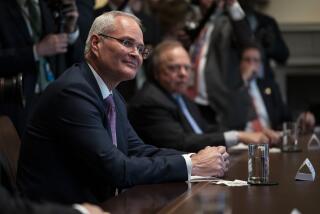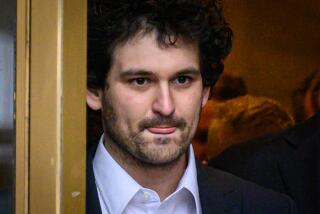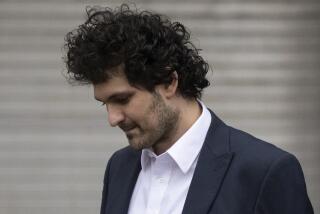COLUMN ONE : Lloyd’s of London Under Fire : Thousands of Americans were among the investors attracted to its high-status syndicates. But now, facing huge losses, many claim the venerable insurer did not tell them how risky the business really was.
To many of his American acquaintances, Charles E. Parnell personified upper-crust British hauteur. He was suave, impeccably dressed, with a whiff of arrogance.
In New York, he stayed at the Pierre; in San Francisco, the Fairmont. He wore dark pin-stripe suits and arrived by limousine. He boasted of keeping four sets of golf clubs in various parts of the world so he would never miss a round.
His was the perfect image for the high-status product he offered: membership as an investor in Lloyd’s of London, the world’s oldest insurance market.
As one of Lloyd’s most prolific recruiters, Parnell crisscrossed America in the 1970s and 1980s seeking investors hoping to profit by betting their fortunes on the vagaries of the wind, the high seas and--increasingly--the U.S. civil justice system.
But today, facing ruinous losses, some of Parnell’s clients and other investors have filed lawsuits accusing Lloyd’s and its network of independent underwriting syndicates of perpetrating an elaborate fraud. They say that Lloyd’s, playing on its historic profitability and prestige, gulled people into pledging their life savings without disclosing the huge financial threat posed by industrial pollution and by asbestos-induced lung disease among American workers.
Not only did Lloyd’s hold back information, these investors say, but it sought out unsuspecting new members to pack onto syndicates that harbored some of the world’s ugliest insurance risks. Meanwhile, according to the lawsuits, Lloyd’s insiders protected themselves by quietly withdrawing from the worst syndicates. All the charges are civil, not criminal.
Lloyd’s denies any wrongdoing and so far has rebuffed a string of U.S. lawsuits.
But its foes are determined. Among them is Richard D. Rosenblatt, a bristly and imposing former bomber pilot who heads the American Names Assn., a group of U.S. investors battling Lloyd’s. Members of the group are among 574 plaintiffs in a federal lawsuit filed against Lloyd’s last fall in San Diego.
In his makeshift war room--an office at his home in Rancho Santa Fe stuffed with court documents, newspaper clippings, fax machines, beepers and cellular phones--the energetic and blunt-spoken Rosenblatt thundered, “It’s probably the biggest swindle of the century, if not forever!”
In lawsuits that have sprouted across the United States, Canada and Britain in the last three years, investors--or “Names,” in Lloyd’s parlance--seek to nullify contracts subjecting them to unlimited liability, “down to the last cuff link,” for losses on insurance policies written by Lloyd’s syndicates. By one estimate, 23,000 Lloyd’s Names, out of a peak membership of 32,000, are involved in litigation against the market, including about two-thirds of the 3,000-plus U.S. Names.
Because the investors ultimately pay the claims on Lloyd’s insurance policies, it is they who bear the weight of four straight years of unprecedented losses, totaling about $12.3 billion, which have pushed the 307-year-old market close to collapse.
U.S. federal courts have ruled in four cases that under the Names’ contracts with Lloyd’s, jurisdiction over legal disputes resides with British courts. But other U.S. cases are pending, including Rosenblatt’s, and some recent decisions in England give Lloyd’s dissidents confidence that the tide may be turning.
Parnell, reached by telephone in London, declined an interview. “I have no comment to make, under advice (of counsel),” he said.
*
Founded in Edward Lloyd’s London coffee shop in 1688, Lloyd’s is not a company but a marketplace where hundreds of individual insurers--the Lloyd’s syndicates--gather to do business.
Lloyd’s is perhaps best known to Americans as the last-resort insurer of offbeat or hard-to-calculate risks, from a concert pianist’s fingers to a satellite launch. A Lloyd’s syndicate once insured a comedy club against the possibility of a customer laughing to death.
But Lloyd’s main business is reinsurance, a risk-spreading mechanism that enables an insurer in, say, California to pass off a portion of its earthquake exposure to a carrier on the other side of the globe, in exchange for a share of the premium. Wherever disaster strikes, chances are that Lloyd’s has a piece of the risk.
Taking all its syndicates together, Lloyd’s ranks as the world’s third-largest reinsurer, with gross premiums of more than $5 billion in 1993. In 1986, its most profitable year, Lloyd’s reaped pretax profits of about $960 million.
The capital that backs up Lloyd’s insurance underwriting comes from the Names, individual investors from all over the world. Last year, as part of a massive reorganization, Lloyd’s began soliciting capital from corporations for the first time, but it is individual Names who are responsible for covering all the previous losses.
What most scalds the pride of some Names is knowing that at least part of their motivation for investing was pure ego. There was great cachet in joining an institution whose members included princesses Alexandra and Michael of Kent, former British Prime Minister Edward Heath, the late publisher Robert Maxwell, tennis star Virginia Wade and assorted dukes, earls and members of Parliament.
“The public’s perception of Lloyd’s as an elite and somewhat aloof organization, with rich customs and still richer patrons, created a powerful draw for those selected to join,” a U.S. Senate subcommittee noted in an investigative report last October.
“It could be sold on snob appeal alone,” affirmed William D. Kilduff, a retired broker for E.F. Hutton in San Francisco who says that he and Hutton collected thousands of dollars in commissions for introducing Parnell to U.S. investors, about 25 of whom became Names.
Snob appeal aside, a Lloyd’s membership was attractive purely as an investment. One of the biggest selling points was “making your money work twice.” A Name didn’t need to hand over the sum being invested but had only to pledge it. Meanwhile, the money could remain invested elsewhere.
As extra security over foreign investors, Lloyd’s required most American Names to obtain letters of credit--essentially IOUs to Lloyd’s for about a third of the total pledge, guaranteed by a U.S. bank. The bank would require collateral to cover the letter of credit, but it wouldn’t necessarily demand cash. Stock or other securities, even an equity interest in a home or business, might do.
Under the direction of “members’ agents” such as Parnell, each Name’s pledge would be divided among several, perhaps dozens, of syndicates within Lloyd’s, ostensibly to spread the risk.
At year’s end, Lloyd’s would send out checks representing each Name’s share of his or her syndicates’ profits, minus agents’ commissions. In good years, profits of 10% or more were typical.
In 1980, the minimum investment was about $330,000. Thus, just by pledging to cover insurance losses if they came, a Name could reap $33,000 a year or more on top of what the same money was earning elsewhere.
It seemed hard to beat.
But recently, instead of collecting checks, Names have been hit with “cash calls”--demands for money to cover their share of their syndicates’ claims losses.
One of the events that rocked Lloyd’s investors came in July, 1988, when the Piper Alpha oil platform exploded on the North Sea, causing losses of more than $1 billion, most of it within Lloyd’s. That was but the first in a record-setting string of catastrophes that included windstorms in Europe, firestorms in Oakland and Southern California and two California earthquakes.
Just as devastating were the cumulative losses in courtrooms across the United States from asbestosis and toxic waste lawsuits against corporations that were deemed to be covered by insurance policies written or reinsured by Lloyd’s syndicates.
By and large, American Names have fared better than their counterparts abroad. Hundreds of British Names have lost their homes or been forced into bankruptcy. Several suicides, including at least two in Canada, have been blamed on the financial devastation.
It isn’t the lumps they’ve already taken that most trouble the Names, it’s those yet to come. Under Lloyd’s accounting system, the books don’t close on a syndicate’s year of business until three years after the calendar year ends--even longer if unquantifiable losses remain from toxic waste or asbestosis claims, for example. A Name could resign from Lloyd’s today and still be dunned for payment from “open years” a generation from now.
*
Onlookers may have trouble sympathizing with well-heeled investors victimized because of their own greed and snobbishness. But not all American Names are necessarily rich status-seekers.
At the time she joined in 1984, Alexandra Carter of Beverly Hills was a 23-year-old college student recovering from multiple skull fractures suffered in a car accident that had killed her boyfriend. Her family was well-to-do, and she had a sizable investment portfolio. But after the accident it was by no means certain that she would ever be able to hold a job, she said.
Carter, who resigned from Lloyd’s two years ago but still faces six-figure cash calls from her syndicates, said the worst part is the uncertainty. Because several of her syndicates have open years, she wonders whether this financial cloud will ever lift.
“Do I dare buy a house? Do I dare get married, or are they going to tag the guy I marry?” she asked.
Elizabeth Bencsics, 78, is a retired part-time legal secretary married to a retired electrician in Rio Rancho, N.M.
Bencsics said that she and her husband are the sort of people who pay cash for everything and were looking for a secure investment to boost their retirement nest egg. Although her husband, Joseph, never earned more than $35,000 a year as an electrician, the couple had subdivided land they’d bought years earlier and had built up a net worth of about $350,000 when they joined Lloyd’s in 1983, she said.
In the beginning, Lloyd’s was a golden goose. Bencsics remembers gains of about $9,000, $12,000 and $20,000 in successive years, nearly all of which she left in her Lloyd’s account. But after the profits came years of much greater losses.
All told, she said, she has lost about $100,000, and although she resigned from Lloyd’s in 1991, she still faces more than $250,000 in cash calls, which would wipe her out if she were forced to pay.
She recalled a remark made by a Lloyd’s representative who visited New Mexico after things had gone sour. “He said, ‘Well, Mrs. Bencsics, if you can’t write a check for $100,000 without thinking about it, then you shouldn’t be a Name.’ ”
*
For many of the Names now accusing Lloyd’s of conspiracy and fraudulent concealment, the smoking gun is a dry, two-page memorandum dated Feb. 24, 1982, and addressed to the chief of the audit department at Lloyd’s. The memo is cited in at least one of the U.S. lawsuits.
“Dear Sir,” the memo begins, “ASBESTOSIS.”
The text beneath the jarring heading discusses, in accountant-speak, the likelihood that U.S. court judgments compensating industrial workers for asbestosis will surpass any amounts previously imagined. And that Lloyd’s syndicates--and the thousands of Names backing them up with their fortunes--are firmly on the hook.
“Most syndicates will incur losses on their own writings of reinsurance business,” states the memo from the accounting firm of Neville Russell, adding, “Very little of this has been advised so far.”
And little was advised for years afterward, the dissident Names contend. They say that even after the Neville Russell letter, there was no concerted effort to inform either current or prospective Names of the dangers.
Meanwhile, say the dissidents, Lloyd’s insiders ducked out of the nastiest syndicates. As proof, dissidents point to studies showing that Lloyd’s insiders have suffered significantly lower losses, on average, than the external Names.
Nor, they allege, was there any letup in the brisk recruitment campaign that caused Lloyd’s membership to quadruple in 13 years, to 32,433 in 1988 from 7,710 in 1975. In fact, that was the whole point, the dissident Names contend: The more investors who could be enticed to join, the lighter the losses that might fall on the rest.
Parnell, a director of Lloyd’s R.W. Sturge syndicate, was a prime contributor to the growth. He cultivated a nationwide network of social and business contacts who introduced him to prospective Names.
Chicago, Cincinnati, Houston, San Francisco and Santa Fe, N.M., among other cities, have large clusters of Names recruited by Parnell, who is in his late 60s and no longer enlisting members.
Thomas K. Reed Jr., who, as a money manager for Smith Barney in Santa Fe, introduced Parnell to Bencsics and more than 100 other investors in New Mexico, said, “I think he had, quite frankly, the sense that this was a wonderful opportunity for everybody.”
Still, Reed, a well-known entrepreneur who has founded and run several companies around Santa Fe, acknowledged that, in retrospect, Bencsics was not an appropriate candidate for Lloyd’s.
“If I did her a disservice, I feel very badly about it, but again, I would have to come back and say that it is her money and there should be a degree of personal responsibility,” said Reed, who added that he was never paid for introducing people to Parnell.
Reed also noted--as Lloyd’s representatives have done repeatedly in their defense--that prospective Names were never admitted to Lloyd’s until they had visited London and met with the Rota Committee, a panel of market executives whose function was to notify every candidate of the meaning of “unlimited liability” and the potential for an investor to be wiped out.
But according to the San Diego lawsuit, the committee never explained the specific threats that Lloyd’s already faced, such as liability for asbestos and industrial pollution claims.
The lawsuit alleges that the information the committee provided “amounted to half-truths, misrepresentations and intentional non-disclosure of the real risks.”
Bencsics’ recollection of her 1983 London trip is a little hazy, although she is certain that there was no discussion of asbestosis. Rather, she said, because she was from New Mexico, “mostly they asked me about Los Alamos and the atomic bomb.”
The dissident American Names assert that under U.S. law, Lloyd’s had a greater disclosure duty than simply explaining the terms of the contract. Fully informed investors never would have joined Lloyd’s in the first place or, if already members, certainly wouldn’t have continued underwriting, they say.
Dissident Names also contend that Lloyd’s memberships were securities that should have been registered with the Securities and Exchange Commission and with appropriate state authorities.
The argument found favor in Ohio, where the state Division of Securities on Nov. 17 accused R.W. Sturge and two of its agents of violating state law by selling memberships without registration. Securities Commissioner Mark V. Holderman said he is contemplating a cease-and-desist order.
The SEC, however, took a different position three years ago. Mary E.T. Beach, senior associate director, wrote that while the agency believed Lloyd’s memberships to be subject to the same laws as more conventional securities--including anti-fraud provisions--they appeared to be exempt from registration requirements.
“Lloyd’s has taken the position that it has done everything within its power to comply with U.S. rules and regulations,” said Sheila H. Marshall of LeBoeuf, Lamb, Greene & MacRae in New York, Lloyd’s U.S. law firm.
Although Lloyd’s thus far has withstood U.S. legal challenges, Rosenblatt thinks that some of the pending lawsuits may find more favor with judges. Dissidents have had more success in England:
* In November, Peter Middleton, the former Marist monk who became Lloyd’s chief executive in 1993, launched an internal investigation into the way that Names were exposed to asbestos losses.
* Also in November, Britain’s second-highest court barred Lloyd’s from collecting $1.5 billion of unpaid losses from an estimated 10,000 Names. The court ruled that Lloyd’s may have violated European Union competition rules and that the issue must go to trial before the money can be collected, which could take a year.
* Earlier last fall, a British judge awarded $780 million to 3,000 Names in the Gooda Walker syndicate at Lloyd’s, finding that syndicate managers had left their investors overly exposed to such disasters as the Exxon Valdez oil spill and Hurricane Hugo.
Experts are divided as to what the outcome of all the legal battles will be, although some observers have speculated that if the dissident Names prevail and are released from their obligation to cover huge outstanding losses, the British government may ultimately have to step in with a bailout for Lloyd’s.
Kilduff, the retired Hutton broker who helped Parnell recruit Names and is himself on the hook for about $500,000, said he is trying to put the experience behind him: “I get a Christmas card from Parnell each year, which I carefully rip up.”
More to Read
Inside the business of entertainment
The Wide Shot brings you news, analysis and insights on everything from streaming wars to production — and what it all means for the future.
You may occasionally receive promotional content from the Los Angeles Times.










